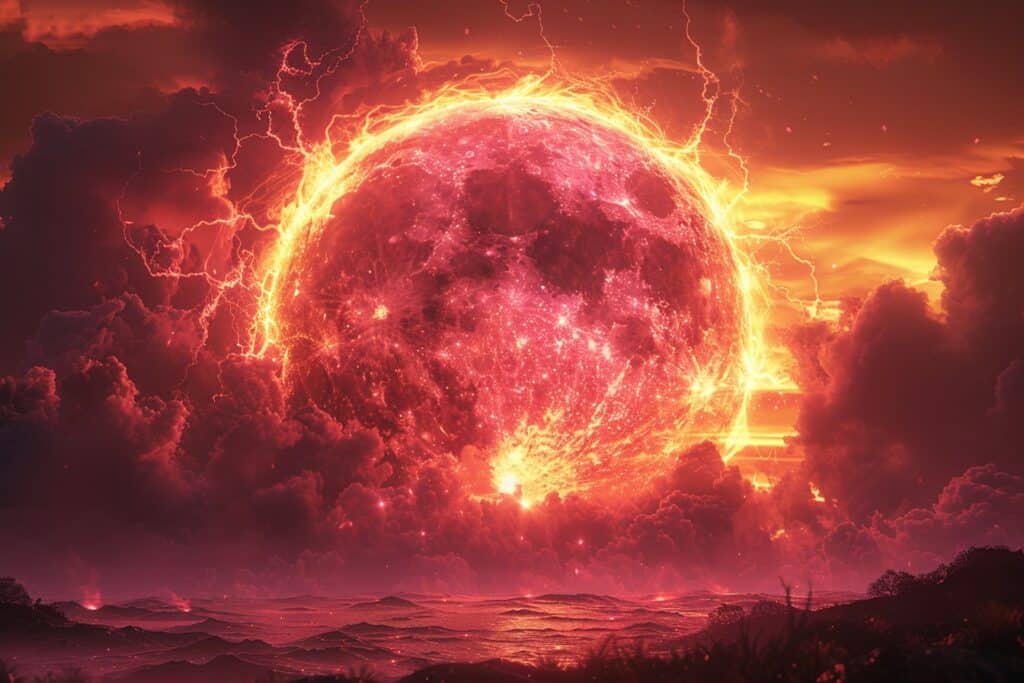Table of Contents
Ymir and the creation of the world is a central myth in Norse mythology, explaining the origin of the cosmos and its elements. According to the myth, Ymir was the first being in the universe, a primordial giant born from the melting ice of Niflheim when it met the hot air of Muspelheim, two of the nine worlds in Norse cosmology.
Ymir was a hermaphroditic entity and produced offspring that became the race of frost giants. From Ymir’s sleeping body, the first male and female giants were born from his armpits, and his legs produced a six-headed son. This progeny began the lineage of giants, a common antagonist in Norse myths.
The turning point in the myth involves the gods Odin, Vili, and Vé, who are among the descendants of the giants. These gods killed Ymir, and his body was used to create the world: his blood formed the seas and lakes; his flesh turned into the land; his bones made the mountains; his teeth and broken bones became rocks and pebbles; his skull created the sky, held up at the corners by four dwarfs (Nordri, Sudri, Austri, and Vestri); and his brain was thrown into the sky to form the clouds.

The Beginning
The Norse cosmos begins with nothing but a great void known as Ginnungagap. To the north of Ginnungagap lies the cold and dark world of Niflheim, filled with ice, frost, and fog. To the south is Muspelheim, a world ablaze with fire and heat. When the ice of Niflheim met the fires of Muspelheim in the middle of Ginnungagap, the ice began to melt, forming the figure of Ymir, the first of the frost giants.
The Birth of Ymir
Ymir, a giant of enormous size and strength, was not born in the traditional sense but emerged from the melting ice. As Ymir slept, the intense heat generated more beings from his body. From his sweat, a male and female giant were born from his left armpit, and his legs fathered a six-headed son. These beings were the ancestors of the frost giants, known as Jotnar.
The Emergence of Búri
Meanwhile, as more ice melted by the heat of Muspelheim, another figure was formed—Búri, the first of the gods. Búri was the progenitor of the Aesir, one of the tribes of gods in Norse mythology. Búri’s son, Borr, married Bestla, a giantess, and they had three sons: Odin, Vili, and Vé.
The Slaying of Ymir
Odin and his brothers grew to dislike the chaotic and destructive nature of the frost giants led by Ymir. Eventually, they decided to kill Ymir. In a colossal battle, Odin and his brothers slew Ymir. His death brought about a cataclysmic flood from his blood, drowning all the frost giants except for two, Bergelmir and his wife, who escaped in a wooden box to continue their kind.
The Creation of the World
After the slaying of Ymir, Odin and his brothers set about creating the world from his corpse:
- His blood formed the oceans and rivers.
- His flesh was used to create the land.
- His bones became the mountains.
- His teeth and shards of bone turned into rocks and pebbles.
- His skull was transformed into the sky, held aloft by four dwarfs named Nordri, Sudri, Austri, and Vestri, representing the four cardinal directions.
- His brains were scattered into the air to become clouds.
The Aftermath
With the world created, Odin and his brothers went on to establish order. They created Midgard, the world of humans, using an eyebrow of Ymir to form its protective barrier. The gods then created the first humans, Ask and Embla, from two tree trunks found on the shore.
Ginnungagap
Ginnungagap -> Consciousness
Ginnungagap, often described as a primordial void or abyss, is a central element in Norse mythology, particularly in the mythological creation narratives. Its name can be interpreted from Old Norse as “yawning gap” or “gaping void,” reflecting its conceptualization as a vast, empty expanse at the beginning of time. Here are some key aspects of Ginnungagap in Norse cosmology:
Location and Cosmic Structure
Ginnungagap is situated between Niflheim, the realm of ice and cold, and Muspelheim, the realm of fire and heat. This positioning is crucial because the interactions between the ice of Niflheim and the fires of Muspelheim across Ginnungagap are what led to the creation of Ymir, the first being, and subsequently, the rest of the cosmos.
Role in Creation
The mythological narrative describes Ginnungagap as the place where the fundamental forces of heat and cold met and mixed, causing the ice from Niflheim to thaw and drip. These drippings formed into Ymir, the progenitor of the frost giants, and Audhumla, the primeval cow. The licking of the salty ice blocks by Audhumla led to the emergence of Búri, an ancestor of the gods. Thus, Ginnungagap is essentially the birthplace of the first creatures and entities in Norse mythology.
Post-Creation Significance
After the creation of the world from the body of Ymir, Ginnungagap’s role as the primordial void becomes less central, but it retains its symbolic significance as the original state of the universe before the ordering of the cosmos by the gods.
